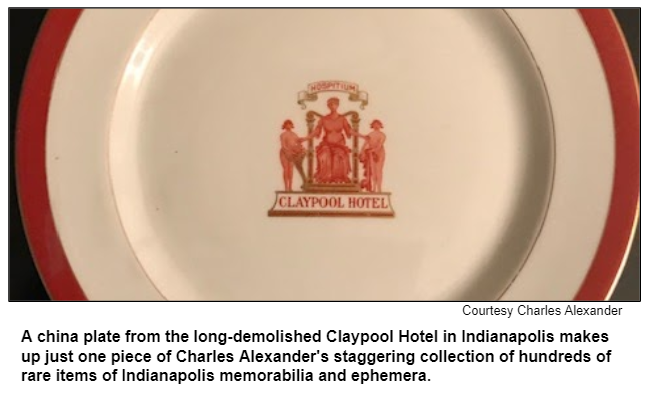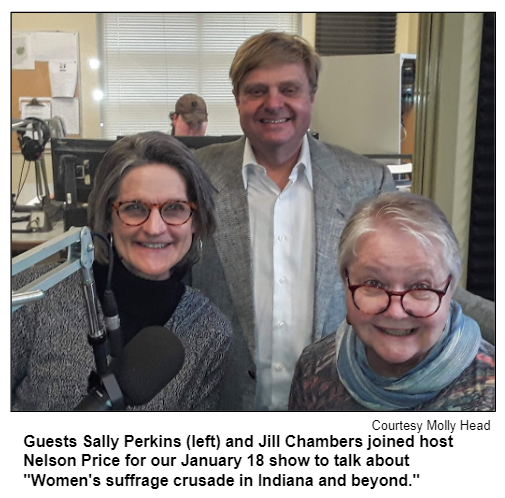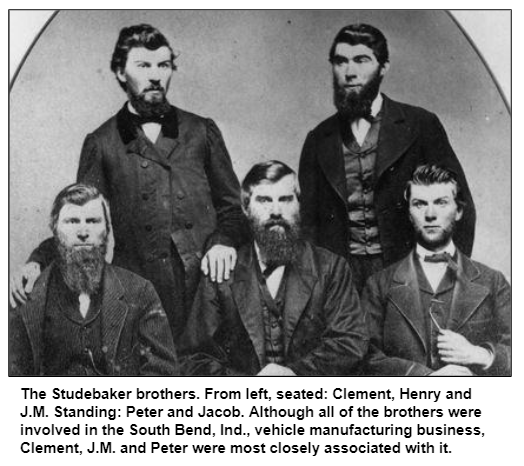
Saturdays, noon to 1 p.m. ET on WICR 88.7 FM.
Or stream audio live from anywhere on WICR Online!
You can listen to recent shows by clicking the podcast links below, or check out our extensive archive of past shows available as podcasts.
January 25, 2020
A collector's guide to Indianapolis memorabilia
Where do you start in describing a staggering collection of hundreds of rare items of Indianapolis memorabilia and ephemera?

His private collection also includes historic photos and postcards depicting the Woodruff Place neighborhood and bygone Riverside Amusement Park; architectural sketches of the Murat Shrine Temple (now the Murat Theatre at the Old National Centre) and the World War Memorial; embossed silverware from the long-demolished Claypool and Lincoln hotels; Amaco art pottery made in Speedway during the Great Depression; and yearbooks from Shortridge and Arsenal Tech high schools.
Although Charles owns a booth at Midland Arts & Antiques Market, none of his rare Indianapolis memorabilia and ephemera is for sale there. Or anywhere else.
"I love the Indianapolis collection too much to sell any of it," says Charles, 63, who began collecting artifacts related to his hometown's heritage as a teenager in the early 1970s.

He's been a full-time antiques dealer for more than 35 years. At Midland, he primarily sells china, silverware and vintage furnishings not made in Indianapolis. He also has moonlighted at auction houses including Christy's of Indiana in Indianapolis, Heimel's Auction in Beech Grove and Burgess Auctions in Knightstown. Those gigs often enable him to get first dibs on rare Indy memorabilia to add to his ever-expanding collection.
Some listeners may recall Charles from his memorable appearance on the PBS series Antiques Roadshow when the program was filmed at the Indiana Convention Center in 2000. Charles, who emphasizes that he's not an appraiser, showed up with a rare World War I poster for which he had paid $35. It turned out to be worth an amount that Charles describes as "far, far more than that."
Fortunately, his Arts & Crafts-style house, which was built in 1917 in the Meridian Park neighborhood, has an attic, a basement and spare bedrooms for storage of his Indianapolis memorabilia and ephemera.
Perhaps not surprisingly, Charles has won the History Mystery prize several times on Hoosier History Live, sometimes drawing on knowledge gleaned while finding local treasures.
He also has put his knowledge to use at the Indiana State Fair, where he has judged 18 categories, primarily pottery and china. In addition, Charles has taught classes in antique china, pottery, glass and silver at various auction houses.
He offers up this tidbit of advice for collectors, using the popular Woodruff Place Flea Market as an example:
"Don't go expecting to find a specific item or treasure. Go to Woodruff Place to enjoy the historic neighborhood that it is. If you find something wonderful, that will be the icing."
History Mystery
Riverside Amusement Park, the iconic entertainment center northwest of downtown Indianapolis that opened in 1903, was depicted in dozens of postcards, including some in the collection of guest Charles Alexander. For many decades, among the most popular attractions at Riverside were two massive roller coasters. Children and teenagers often debated which of the two roller coasters was more frightening.
After flourishing for more than 60 years, Riverside closed in 1970. The two dueling roller coasters were removed from the site, along with the other rides and attractions, which included a Ferris wheel, a miniature railroad and a water slide.
Question: Name at least one of the two roller coasters at bygone Riverside Amusement Park.
The call-in number is (317) 788-3314. Please do not call into the show until you hear Nelson pose the question on the air, and please do not try to win the prize if you have won any other prize on WICR during the last two months. You must be willing to give your name and address to our engineer and be willing to be placed on the air.
The prizes this week are a gift certificate to Story Inn in Brown County, courtesy of Story Inn, and two admissions to the Indiana State Museum, courtesy of the Indiana State Museum.
Celebrating a century of women's suffrage
Nelson Price, host and historian
Molly Head, producer/general manager, (317) 927-9101
Michael Armbruster, associate producer
Cheryl Lamb, administrative manager
Richard Sullivan, senior tech consultant
Pam Fraizer, graphic designer
Garry Chilluffo, consultant
Please tell our sponsors that you appreciate their support!

 For organizational sponsorship, which includes logos, links, and voiced credits in the show and in podcasts, contact producer Molly Head at (317) 927-9101 or email her at molly@hoosierhistorylive.org. Our podcast listens are increasing at a rate of 17% a month!
For organizational sponsorship, which includes logos, links, and voiced credits in the show and in podcasts, contact producer Molly Head at (317) 927-9101 or email her at molly@hoosierhistorylive.org. Our podcast listens are increasing at a rate of 17% a month!
Acknowledgments to Visit Indy, Fraizer Designs, WICR-FM, Henri Pensis, Aaron Duvall, Chloe Tyson, and many other individuals and organizations.
Thank you!
We'd like to thank the following recent, new and renewal contributors whose donations help make this show possible!
- Bruce and Julie Buchanan
- David Willkie
- Coby Palmer in memory of Gary BraVard
- Tim Harmon
- Jane Simon Ammeson
- Kathleen Angelone
- Chuck and Karen Bragg
- "Jingle Bell Rock" in memory of Bobby Helms
- Theresa and Dave Berghoff
- Dr. William McNiece
- Ann Frick
- Margaret Smith
- Carl and Kathleen Widland
February 1, 2020 - coming up
Studebakers: the brothers, the cars and the legacy
For many generations of South Bend residents, Studebaker Brothers - which later became the Studebaker Corp. - was the largest employer in town.
It all began in 1852 when the two oldest of five Studebaker brothers - Henry and Clement - opened a blacksmith shop, pursuing a trade they had been taught by their father. By the 1880s, Studebaker was the largest maker of vehicles - wagons, carriages and sleds, at that point - in the world.

Although the final Studebaker car to be assembled in South Bend rolled off the production line in 1963, thousands of aficionados around the world continue to drive them.
Among the most popular destinations for visitors to South Bend is the three-story Studebaker National Museum, where galleries include exhibits of U.S. presidential carriages. Among the crown jewels displayed at the Studebaker museum: the Barouch carriage that transported the Lincolns to Ford's Theatre on the night of the president's assassination in 1865.
For a motoring excursion through a broad landscape of Studebaker history, our two guests will be:
- Andy Beckman of South Bend, the archivist for the Studebaker National Museum and past president of the Society of Automotive Historians. The museum, which has 55,000 square feet and galleries of vintage cars and wagons, also houses the archives of the Studebaker Corp. and other South Bend businesses dating to the 1850s.
- Bob Palma of Brownsburg, who writes Studebaker columns for auto collector publications, including Hemmings Classic Car magazine; he also serves as the technical editor for the Studebaker Drivers Club's magazine, Turning Wheels. The owner of a fleet of four Astra white 1964 Daytona models (the last model year of South Bend production), Bob is retired from a career that included teaching auto mechanics at Arsenal Tech High School and editing industrial arts textbooks. During the mid-1950s, his father co-owned a Studebaker dealership.

At various times, all five Studebaker brothers were involved in the business, although Clement (1831-1901), J.M. and Peter (1836-1897) were most closely associated with it. Clement's mansion, built during the 1880s and christened Tippecanoe Place, is now home to a popular restaurant in South Bend.
During World War II, Studebaker manufactured trucks and other vehicles used by the military. After the war, the company returned to making popular cars for middle-class Americans; our guest Bob Palma notes their 1947 models were touted with the slogan "first by far with a postwar car."
© 2020 Hoosier History Live. All rights reserved.
|








